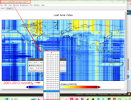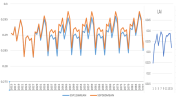(default) [user@cesm2.2 ]$ ncdump -h ~/cesmlab/lnd/clm2/lai_streams/MODISPFTLAI_0.5x0.5_c140711.nc
netcdf MODISPFTLAI_0.5x0.5_c140711 {
dimensions:
lat = 360 ;
lon = 720 ;
time = 156 ;
variables:
float area(lat, lon) ;
area:long_name = "area" ;
area:units = "km^2" ;
int mask(lat, lon) ;
mask:long_name = "land mask from pft dataset, indicative of real/fake points" ;
mask:units = "unitless" ;
float LATIXY(lat, lon) ;
LATIXY:long_name = "latitude-2d" ;
LATIXY:units = "degrees north" ;
float LONGXY(lat, lon) ;
LONGXY:long_name = "longitude-2d" ;
LONGXY:units = "degrees east" ;
float time(time) ;
time:_FillValue = 9.96921e+36f ;
time:long_name = "time" ;
time:units = "days since 2001-01-01 00:00:00" ;
float lat(lat) ;
lat:long_name = "latitude-2d" ;
lat:units = "degrees north" ;
lat:cell_methods = "lon: mean" ;
float lon(lon) ;
lon:long_name = "longitude-2d" ;
lon:units = "degrees east" ;
lon:cell_methods = "lat: mean" ;
float LAI_1(time, lat, lon) ;
LAI_1:_FillValue = -9999.f ;
LAI_1:long_name = "Leaf Area Index" ;
LAI_1:units = "m2/m2" ;
LAI_1:cell_methods = "pft: mean" ;
float LAI_2(time, lat, lon) ;
LAI_2:_FillValue = -9999.f ;
LAI_2:long_name = "Leaf Area Index" ;
LAI_2:units = "m2/m2" ;
LAI_2:cell_methods = "pft: mean" ;
....... ....... ....... ....... ....... .......
float LAI_15(time, lat, lon) ;
LAI_15:_FillValue = -9999.f ;
LAI_15:long_name = "Leaf Area Index" ;
LAI_15:units = "m2/m2" ;
LAI_15:cell_methods = "pft: mean" ;
float LAI_16(time, lat, lon) ;
LAI_16:_FillValue = -9999.f ;
LAI_16:long_name = "Leaf Area Index" ;
LAI_16:units = "m2/m2" ;
LAI_16:cell_methods = "pft: mean" ;
// global attributes:
:source = "Peter Lawrence, NCAR" ;
:creation_date = "Wed Jun 11 14:25:36 MDT 2014" ;
:title = "MODISPFTLAI0.5x0.5" ;
:history = "Thu Jul 10 13:24:21 2014: ncatted -a pft_number,global,c,c,Number of pfts in original file: 17 /project/bgc01/swensosc/lnd_lai_streams/MODISPFTLAI0.5x0.5.nc\n",
"Thu Jul 10 13:24:05 2014: ncks --64 -A -v LAI_16 tmp.nc /project/bgc01/swensosc/lnd_lai_streams/MODISPFTLAI0.5x0.5.nc\n",
"Thu Jul 10 13:23:35 2014: ncks --64 -A -v LAI_15 tmp.nc /project/bgc01/swensosc/lnd_lai_streams/MODISPFTLAI0.5x0.5.nc\n",
"Thu Jul 10 13:23:06 2014: ncks --64 -A -v LAI_14 tmp.nc /project/bgc01/swensosc/lnd_lai_streams/MODISPFTLAI0.5x0.5.nc\n",
"Thu Jul 10 13:22:39 2014: ncks --64 -A -v LAI_13 tmp.nc /project/bgc01/swensosc/lnd_lai_streams/MODISPFTLAI0.5x0.5.nc\n",
"Thu Jul 10 13:22:13 2014: ncks --64 -A -v LAI_12 tmp.nc /project/bgc01/swensosc/lnd_lai_streams/MODISPFTLAI0.5x0.5.nc\n",
"Thu Jul 10 13:21:52 2014: ncks --64 -A -v LAI_11 tmp.nc /project/bgc01/swensosc/lnd_lai_streams/MODISPFTLAI0.5x0.5.nc\n",
"Thu Jul 10 13:21:30 2014: ncks --64 -A -v LAI_10 tmp.nc /project/bgc01/swensosc/lnd_lai_streams/MODISPFTLAI0.5x0.5.nc\n",
"Thu Jul 10 13:21:09 2014: ncks --64 -A -v LAI_9 tmp.nc /project/bgc01/swensosc/lnd_lai_streams/MODISPFTLAI0.5x0.5.nc\n",
"Thu Jul 10 13:20:51 2014: ncks --64 -A -v LAI_8 tmp.nc /project/bgc01/swensosc/lnd_lai_streams/MODISPFTLAI0.5x0.5.nc\n",
"Thu Jul 10 13:20:34 2014: ncks --64 -A -v LAI_7 tmp.nc /project/bgc01/swensosc/lnd_lai_streams/MODISPFTLAI0.5x0.5.nc\n",
"Thu Jul 10 13:20:16 2014: ncks --64 -A -v LAI_6 tmp.nc /project/bgc01/swensosc/lnd_lai_streams/MODISPFTLAI0.5x0.5.nc\n",
"Thu Jul 10 13:20:02 2014: ncks --64 -A -v LAI_5 tmp.nc /project/bgc01/swensosc/lnd_lai_streams/MODISPFTLAI0.5x0.5.nc\n",
"Thu Jul 10 13:19:46 2014: ncks --64 -A -v LAI_4 tmp.nc /project/bgc01/swensosc/lnd_lai_streams/MODISPFTLAI0.5x0.5.nc\n",
"Thu Jul 10 13:19:37 2014: ncks --64 -A -v LAI_3 tmp.nc /project/bgc01/swensosc/lnd_lai_streams/MODISPFTLAI0.5x0.5.nc\n",
"Thu Jul 10 13:19:28 2014: ncks --64 -A -v LAI_2 tmp.nc /project/bgc01/swensosc/lnd_lai_streams/MODISPFTLAI0.5x0.5.nc\n",
"Thu Jul 10 13:19:18 2014: ncks --64 -A -v LAI_1 tmp.nc /project/bgc01/swensosc/lnd_lai_streams/MODISPFTLAI0.5x0.5.nc\n",
"Thu Jul 10 13:19:09 2014: ncks -A -v lon tmp.nc /project/bgc01/swensosc/lnd_lai_streams/MODISPFTLAI0.5x0.5.nc\n",
"Thu Jul 10 13:19:09 2014: ncks -A -v lat tmp.nc /project/bgc01/swensosc/lnd_lai_streams/MODISPFTLAI0.5x0.5.nc\n",
"Thu Jul 10 13:19:08 2014: ncrename -v TIME,time /project/bgc01/swensosc/lnd_lai_streams/MODISPFTLAI0.5x0.5.nc\n",
"Thu Jul 10 13:19:08 2014: ncrename -v AREA,area /project/bgc01/swensosc/lnd_lai_streams/MODISPFTLAI0.5x0.5.nc\n",
"Thu Jul 10 13:19:08 2014: ncrename -v LANDMASK,mask /project/bgc01/swensosc/lnd_lai_streams/MODISPFTLAI0.5x0.5.nc\n",
"Thu Jul 10 13:19:08 2014: ncks -v LATIXY,LONGXY,TIME,AREA,LANDMASK /project/bgc01/lawrence/modispft/modispft0.5x0.5/MODISPFTLAI0.5x0.5.nc tmp.nc" ;
:NCO = "20140710" ;
:pft_number = "Number of pfts in original file: 17" ;
}


